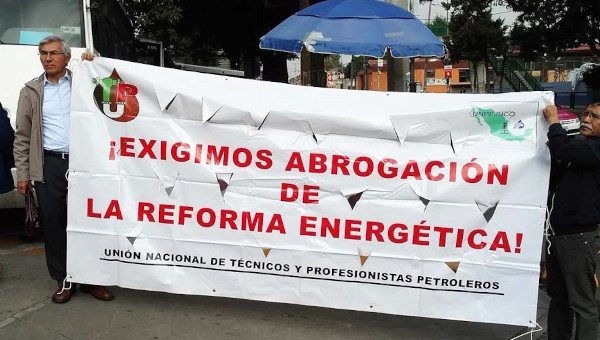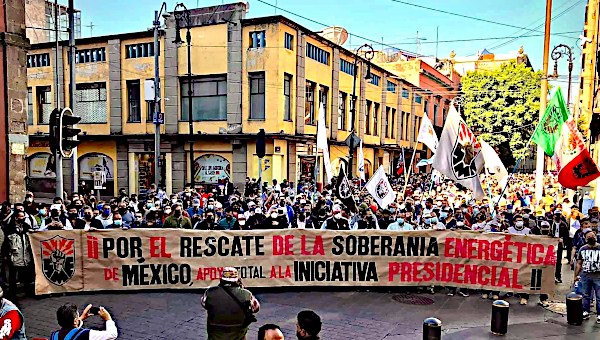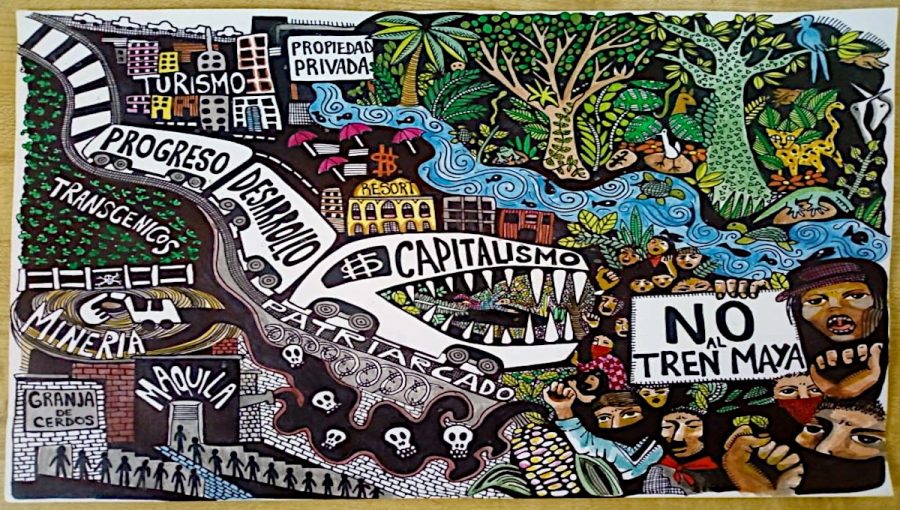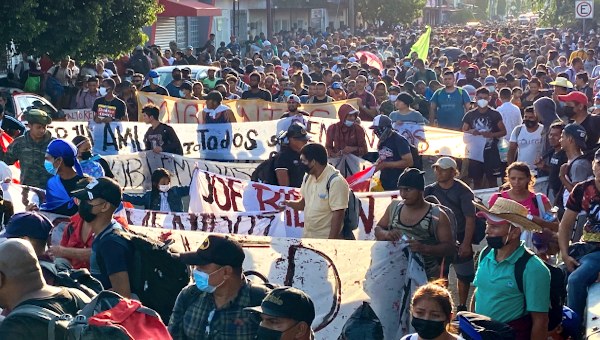Mexico: The Murder of a Union and the Rebirth of Class Struggle
Part 1: The New Assault
“Brothers, companeros, comrades: we must convert the rage, the anger and the helplessness into superior organization, into unified and convergent projects, into cultivating unity without distinctions of any kind, to confront our class enemies because sooner or later, we shall overcome. Forthcoming actions are yet to come and we will come together there again, as we always do, with proletarian pride and with our classist and combative conviction.”1 Central Committee, SME, November 13, 2009.
“We are on the threshold of the bicentenary of Independence and the centenary of the Mexican Revolution, and we have to defeat, as before, the transnationals, the dictatorship, the tyranny and the violations of the Constitution. It’s time for the people to organize themselves.” Martín Esparza Flores, Secretary-General, of SME, quoted in La Jornada, Nov. 12, 2009.
Class Struggle Escalates in Mexico
The neoliberal war on the working people of Mexico reached a new intensity with the government’s lightning assault on the power workers union, the Sindicato Mexicano de Electricistas (SME – Mexican Electrical Workers Union), and on Mexico’s energy resources on October 10. The military takeover of the Luz y Fuerza del Centro (LyFC – Central Light and Power Company) and subsequent extra-constitutional liquidation of the company, firing of all 44,000 workers, and throwing out of the collective agreement has not led to a collapse of resistance as anticipated by the government. On the contrary, it has led to a spirited class resistance and an expansion of the struggle to wider sectors of the working class and the population more generally. The government has unintentionally forged a unity of resistance that has been lacking in Mexico and placed the working class and workers’ demands at the center of popular resistance to the authoritarian neoliberal regime.
The centrality of worker and union demands in a broad and growing resistance movement differentiates 2009 from both 1968 and 2006. In 1968 and 2006, the demands spoke to broad issues of democratic rights. In 1968, students led protests against the one-party authoritarian regime. In 2006, the mass mobilizations in Mexico City and elsewhere protested the fraud perpetrated in the Presidential election. Students were the central actors in 1968; the populist candidate for President was the central actor in 2006, supported by a mass base, heavily working class, but not organized with their own voice and organizational structure. Government-linked authoritarian unions actively opposed both the 1968 and 2006 protests while other unions played an ancillary or marginal role, if any at all.
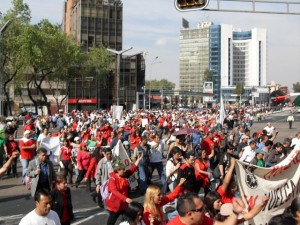
The absence of genuine unions and a national labour movement is both a consequence of Mexico’s quasi-corporatist labour institutions and a key factor in sustaining these institutions. The neoliberal governments have deliberately sustained the most undemocratic and corrupt unions to keep workers fragmented and under control while continuing the neoliberal assault. Union membership is, in fact, very low in Mexico, especially if you were to peel away the layers of protection contracts and charro2 unions. Of the approximately five million “unionized” workers in Mexico, it’s estimated that at least 85% have protection contracts, fake contracts signed by corrupt union officials to exclude genuine unions. Of the remaining 15%, most are members of charro unions, corrupt, authoritarian, quasi-corporatist, government-linked unions. Thus most of the working class has continued to lack organizations through which to build effective fight backs against the relentless neoliberal assault that has devastated living standards, workplace health and safety, and workers’ rights in general.
Two of the most important of the charro unions are the oil workers union and the national teachers union. Both are undemocratic, corrupt and collaborate with the government on the implementation of the neoliberal agenda. But both, as well as the charro unions in the industrial sector, have been curiously silent in the present situation. Though they haven’t expressed any support for the SME struggle, they haven’t attacked it. This is a far cry from the role of charro unions during previous worker insurgencies when they’ve actively participated in denouncing and repressing the insurgents. Their silence may speak of caution, bargaining leverage with the government, or fears that they could be next if they don’t toe the line.
The revolt in Oaxaca 2006 was different than either 1968 or the anti-fraud movement of 2006 and could prove to be a precursor of the emerging developments in Mexico City and the nation (Roman and Velasco). The dissident Oaxaca state section 22 of the national teachers union played a central role in a major, though localized, civil insurgency. Unlike those other insurgencies, a union struggle was the precipitant and backbone of what became a deep and broad rebellion. The vicious repression of the union by the state government precipitated a mass uprising by vast sectors of the Oaxaca population. Today, as in Oaxaca 2006, the simmering discontents of various sectors have been ignited by anger at the attack on workers and their union. But the present unity of vast sectors of the working class, students, and others, is not simply based on a potpourri of separate demands but by the widely-held belief that these separate grievances are rooted in the character of the neoliberal authoritarian regime and its current President, though there are differences as to whether that character is simply political (authoritarian neoliberal) or linked inextricably to capitalism.
The government’s action has been viewed as a declaration of open warfare on unionism and an attempt to further open the treasure chest of Mexico’s energy resources for distribution to foreign and domestic capitalist interests. The government has eliminated room for narrow trade union bargaining and sectoral solutions. It has forced workers’ demands to be cast in class and political terms. Even some important unions that had sought to carve out a place for themselves within the neoliberal project have realized that if the government succeeds in destroying the SME, they could be next. SME’s struggle has resonated for vast sectors of the working class and broader population – workers, peasants, students, intellectuals, small business, for a variety of reasons: 1) it is seen as an attack on the Constitution and the demonstration of contempt for legality; 2) it is seen as the end of hope for a democratic transition; 3) most of the Mexican population has been pauperized by decades of neoliberalism, this pauperization now intensified by the global economic crisis, and further deepened by the deliberate austerity and regressive policies just enacted by the PAN government, with the support of the PRI.
The fall of the one party system in the Presidential election of 2000 created great hopes that peaceful, electoral change could come and pave the way for improvements in people’s lives, a decrease of repression, and greater opportunities. On the contrary, things have only become worse economically and the regime more militarized and repressive. Electoral competition within the framework of an authoritarian, neoliberal state has changed little. The Presidential electoral fraud of 2006 sharply dimmed the hopes that the Left would ever be allowed to win the Presidency. But these lingering hopes have been further smashed by the blatant use of extra-legal means to carry out neoliberal policy and serve capitalist greed. The ongoing militarization of Mexico has been brought to the workplaces of the capital of the country. The Army and the paramilitary national police now occupy all the workplaces of the LyFC in Mexico City and surrounding states. Mexico is at a crossroads. Either the working class and popular movements will defeat the government or the government will defeat them.
The New Assault
The dramatic assault by thousands of soldiers and the militarized Federal Preventive Police of Mexico on the public power utility of central Mexico, its workers, and its union was an attack on Mexico’s Constitution and legal processes as well as a heinous assault on public interests and workers rights. The President, on the night of October 10, without the required approval of Congress, ordered the military occupation of all the workplaces of the Central Light and Power Company of Mexico and violently expelled the workers. The President then issued a decree announcing the liquidation of the company, the firing of all its workers, and the end of the union contract. It carried out these actions with little regard to the formal processes required by the Mexican Constitution and Mexican law. And, when a judge, issued an injunction (Amparo) to halt the liquidation process on November 6, the Secretary of Labour contemptuously said that the court decision doesn’t matter, the action is a fait accompli. As a killer of dreams and rights, he used the metaphor of death, saying about the action and the court edict: “When a person dies, although the official death certificate has not been issued, the person is already dead.” So much for respect for legal processes.
The government decided to skip the messy processes of going to Congress as required by the Constitution as Congress has been subject to popular pressures that have, in recent years, stalemated the long neoliberal offensive, especially in regard to the privatization of energy. The government’s bold action is both a message and a series of gambles. The message is that it will use military force, when necessary, to break the back of worker and popular resistance without regard to formal legal processes. The gambles are that the majority in Congress – with the old ruling party, the PRI (Partido Revolucionario Institucional – Institutional Revolutionary Party), cooperating with the President’s party, the PAN (Partido Acción Nacional – National Action Party) – would not challenge an action enthusiastically supported by Big Business and foreign capital and that worker resistance would quickly melt away in the face of overwhelming force, reasonable severance pay, and vague promises of jobs in the new company, yet to be organized. The government is making clear that legal formalities will not stand in the way of state policy and capitalist interests. But it is also, unintentionally, making clear that the electoral and institutional route to social change may have no viability in Mexico. Nevertheless, the SME is pursuing a two-track policy of fighting back: a variety of legal challenges and escalating extra-parliamentary protests. It has won one legal challenge, the Amparo, to cease the procedures of the liquidation of the union contract and the formal firing of all the workers. It recently lost a second challenge – the refusal by the Supreme Court to hear the challenge by the assembly of Mexico City to the President’s constitutional right to liquidate the company.
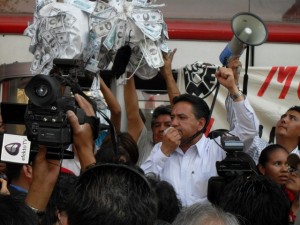 The lightning attack had been preceded by a long propaganda war by government and the capitalist media to portray the LyFC as inefficient and corrupt and, of course, to blame the union for these problems. The company, in fact, did have major problems of deficits and deteriorating services. But these problems were not due to inefficient workers or the power of the union. The LyFC is only a distributor of power with only token power production. It bought almost all the power it distributed from the La Comisión Federal de Electricidad (CFE – Federal Electricity Commission), the other state owned power company, and the government’s policy was to have the CFE charge more than it allowed the LFC to charge consumers. By keeping power costs below their real costs, the government subsidized consumers who only had to pay one-third to one-half of the real costs. And it provided much larger subsidies to itself and many large companies located in central Mexico by allowing them to completely ignore payment of their power bills. These policies along with decreasing the investment budget for the LyFC created large deficits for the LyFC. The union did not create the deficits and deteriorating infrastructure. It had no power over these policies. Yet the corporate media and the government blamed the privileges of the workers and the union for all the resultant problems while ignoring their real sources. This was all part of the long “war of position” of the capitalist class to undermine sympathy for workers and unions by scapegoating them for the problems, problem that were real but whose roots were elsewhere.
The lightning attack had been preceded by a long propaganda war by government and the capitalist media to portray the LyFC as inefficient and corrupt and, of course, to blame the union for these problems. The company, in fact, did have major problems of deficits and deteriorating services. But these problems were not due to inefficient workers or the power of the union. The LyFC is only a distributor of power with only token power production. It bought almost all the power it distributed from the La Comisión Federal de Electricidad (CFE – Federal Electricity Commission), the other state owned power company, and the government’s policy was to have the CFE charge more than it allowed the LFC to charge consumers. By keeping power costs below their real costs, the government subsidized consumers who only had to pay one-third to one-half of the real costs. And it provided much larger subsidies to itself and many large companies located in central Mexico by allowing them to completely ignore payment of their power bills. These policies along with decreasing the investment budget for the LyFC created large deficits for the LyFC. The union did not create the deficits and deteriorating infrastructure. It had no power over these policies. Yet the corporate media and the government blamed the privileges of the workers and the union for all the resultant problems while ignoring their real sources. This was all part of the long “war of position” of the capitalist class to undermine sympathy for workers and unions by scapegoating them for the problems, problem that were real but whose roots were elsewhere.
At one point, below-cost charges for electric power was part of the social wage (along with subsidized food prices), a policy of maintaining support among the population while keeping wage demands down as well as a way of encouraging capitalist development through low input costs. But with the shift to neoliberalism and an export-oriented economy, the government has been removing all subsidies to working people while leaving them in place for big companies. This long and ongoing propaganda war against unions and public ownership has created hostility to the LyFC and the SME in some segments of the population. It is an ideological battle that the union is fighting by exposing the hidden policies of subsidies to the private sector.
The fact that the CFE, the state-owned power company that handles production and distribution of electric power for areas outside the jurisdiction of the LyFC, is taking over the LyFC(without going through the necessary legal processes) may seem puzzling. But the mystery disappears when we learn that the CFE has already quietly contracted out significant amounts of power production to private companies and has a compliant, undemocratic, corrupt, charro union, the SUTERM (Sole Union for Electrical Workers of the Mexican Republic), a union that will not challenge the government’s plans for privatization and squeezing workers more. As well, there are serious charges of corruption regarding the processes of contracting out as noted in a recent indictment filed by the U.S. Department of Justice.
This attack on the SME and LyFC had three key purposes: to revive the stalled campaign to privatize all public resources, with the big prize being oil; to make the massive fiber optic cable system of LyFC available to private capital for the use in third generation telecommunications; to destroy the Mexican Electrical Workers’ Union (SME), which has played a central role in organizing broad coalitions in opposition to neoliberalism and privatization. The SME is an independent and democratic union with a long history of resistance to privatization, solidarity with social movements and support for the indigenous peoples of Mexico. It has a 95 year history of democratic elections with competing slates and secret balloting. The attack on the SME is not only an attack on the electrical workers but an attempt to break the back of any resistance to neoliberalism and privatization. It is an attack on all working people.
Mexico has been going through a fundamental transformation in the last decades whose key ingredients are:
- the deep integration of the Mexican economy and labour force into the U.S. economy and labour market;
- the growing importance of multinational capital, especially from the U.S. and Spain, within Mexico;
- the replacement of Bonapartism by the more direct role of Capital in shaping government policy;
- electoral liberalization in the form of delimited and constrained electoral competition – though a Left victory at the Presidential level continues to be excluded;
- the neoliberal assault on the social contract which involves the breaking of the class equilibrium, which was part of the basis of stability of the Bonapartist state;
- the decreasing legitimacy of the state as a result of both the neoliberal assault and the continuation of the systemic use of fraud and voter exclusion in controlling the outcome of presidential elections;
- the decreasing legitimacy and efficacy of the state as a result of the increase in drug cartel violence – this is a growth of a form of warlordism which can best be understood as a fight within the state and between the cartels rather than a fight between the state and the cartels;
- and because of 6 and 7, the consequent increase in reliance on militarization, criminalization, repression, and state terror as methods of social control.
Intensified repression and exclusion has grown alongside a multi-party Congress and electoral competition. As with the previous one-party regime, it is not a monolithic state but one with competition and conflict within the very limited boundaries of the regime. In the old regime, the battles took place within and around the ruling party, often out of view of the public. While the battles now take place in broader arenas – both within, between and around the competing parties, the boundaries of this competition are maintained within the project promoted by Big Capital, domestic and foreign. And these boundaries are enforced with brutal repression (witness the state terror against the people of Atenco, the repression of the miners-steelworkers’ union, the Acteal massacre in Chiapas, and now the liquidation of the SME).
The military-police state aspects of the new regime are even more pronounced than under the old regime, a regime that built a power bloc that relied on a mix of repression, cooptation, and concessions. The denial of the right of association by the state remains intact; there has been no democratic transition in unions or state-union relations. The old authoritarian-developmentalist state gave certain social and economic citizenship rights to strategically significant sectors of the population as a control device and to develop the internal market for domestic capital. The new, neoliberal state has taken away most of those social and economic citizenship rights. Their export strategy has made domestic purchasing power less important. The important thing in this strategy is low wages, disciplined and pliable labour, and no worker resistance. The new neoliberal authoritarian state is not willing or able to give concessions; in place of concessions, it has imposed cutbacks and forced give-backs.
The neoliberal assault on popular rights, livelihoods, and opportunities has demolished hopes for a better future within Mexico. Concessions and hope were a basis of a partial acceptance, albeit fatalistically, of the authoritarian regime, which offered the hope – and for a period the reality – of creating a better material life for oneself and one’s family or children through education and hard work. While Mexico’s recurrent economic crisis undermined those hopes, the prospect of a “democratic transition” renewed them for large sectors of the population. The belief that there would be a democratic transition and that it would lead to improved life opportunities and less repression have been dashed by the neoliberal authoritarian political policies and practices.
The assault on SME is part of a broader effort to pass the burden of the economic crisis onto the backs of an already unemployed, underemployed and hungry population. In addition to the attack on SME, the government has enacted an austerity budget making major cuts to all social spending, especially targeting public universities and increasing taxation on working people while continuing to exempt the big corporations. The sales tax was raised from 15% to 16% and taxes on wages and salaries were also increased, while Mexico’s biggest companies will still be allowed their exemptions and legal evasion of taxes. As the Mexican Treasury Department itself pointed out, the 400 largest corporations in Mexico pay almost no taxes. They have paid taxes at an average rate of 1.5% for several decades. When this issue was raised by the left opposition in Congress, even the President grumbled publicly about the lack of tax contributions by big business, raising the ire of the big business organizations and causing the President to back pedal on his remarks two days later.
These regressive tax policies, nevertheless, have received the strong endorsement of Juan José Daboub, the Managing Director of the World Bank, at the Mexican Business Summit in Monterrey, Mexico, where on November 8, 2009, he praised the government and described the increase in regressive taxation as proof of Mexico’s “political maturity.” Not satisfied with the increase in regressive taxation, he called on the government to move forward on changes to labour legislation and to improving the energy system, code words for weakening workers’ rights and privatizing energy (Carrizales and González Amador). •
Resources
- David Carrizales and Roberto González Amador, “El Banco Mundial considera prueba de “madurez política’ el aumento de impuestos,” La Jornada, November 9, 2009.
- Luis Hernández Navarro, “La Asamblea Nacional de Resistencia Popular,” La Jornada, Oct. 27, 2009
- Office of Public Affairs, U.S. Department of Justice. “Former General Manager of Texas Business Arrested for Role in Alleged Scheme to Bribe Officials at Mexican State-Owned Electrical Utility.”
- Richard Roman & Edur Velasco Arregui, “The Oaxaca Uprising: Implications for Mexico,” in Socialist Register 2008: Global Flashpoints – Reactions to Imperialism and Neoliberalism, edited by Leo Panitch and Colin Leys. New York: Monthly Review Press, 2008; also available as “The Mexican Crisis and the Oaxaca Commune.”
Endnotes
- All translations are by the authors.
- The term charrazo was used to describe a coup by the state and some opportunistic leaders in the railway workers union against the elected leadership of the union in 1948. It has become a general term in Mexico to describe corrupt, undemocratic union leaders and practices. A charro refers to a leader and charrismo to the practice of state-linked, corrupt, undemocratic unions. The term derives from the highly stylized horsemen’s attire worn by the imposed leader. It is now a term of opprobrium often chanted in labour demonstrations. There is a range of charro unions and practices in terms of the degree to which, for whatever purposes, they seek to defend workers and collective agreements and the degree to which they simply seek to sell control. While once an integral part of the ruling party in a one-party regime, they now can best be described as regime-linked, working with whichever of the two neoliberal parties are in power in particular states and nationally and trying to manoeuvre within the rivalry between these parties to better leverage their bargaining power in terms of preserving their control of their unions.


